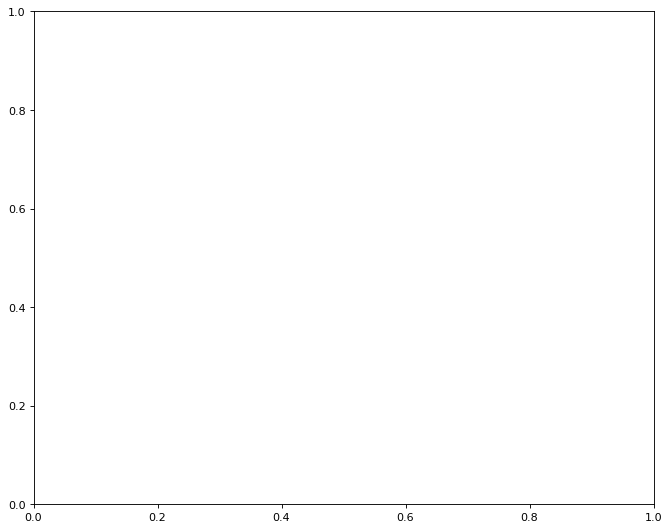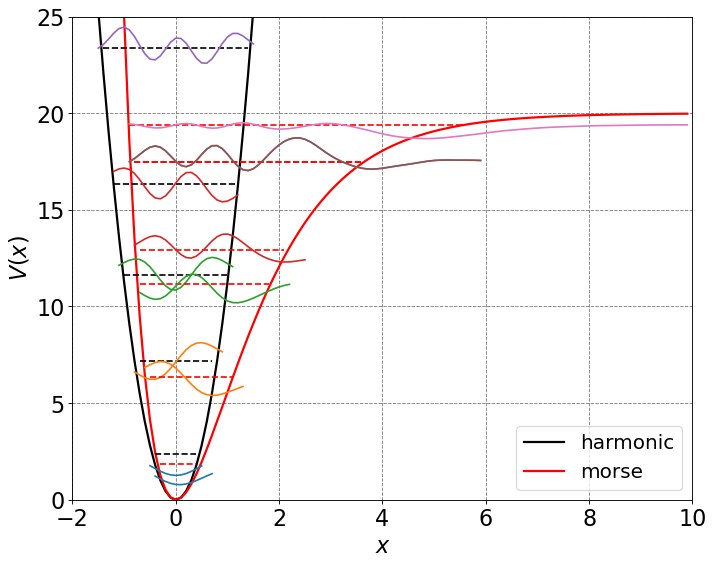# import standard libraries
import numpy as np
import matplotlib.pyplot as plt
# define function to initialize "pretty" plots
def define_figure(xlabel="X",ylabel="Y"):
# setup plot parameters
fig = plt.figure(figsize=(10,8), dpi= 80, facecolor='w', edgecolor='k')
ax = plt.subplot(111)
ax.grid(b=True, which='major', axis='both', color='#808080', linestyle='--')
ax.set_xlabel(xlabel,size=20)
ax.set_ylabel(ylabel,size=20)
plt.tick_params(axis='both',labelsize=20)
return ax
4.5.26. The Morse Oscillator#
A harmonic potential is only an adequate description of a bond energy near the minimum of the potential. A better description of a bond potential is the Morse potential which is given as
\(V(x) = D_e\left(1-e^{-\beta x}\right)^2\)
where \(D_e\) is the dissociation energy and \(\beta\) controls the curvature of the potential.
# plot morse potential and harmonic potential
De = 20.0
beta = 0.75
xvals = np.arange(-1.5,5,0.1)
# second order Taylor series expansion of Morse potential
def harmonic(x):
return De*beta**2*x**2
def morse(x):
return De*(1-np.exp(-beta*x))**2
ax = define_figure(xlabel="$x$",ylabel="$V(x)$")
# compute potential energies
U_h = harmonic(xvals)
U_morse = morse(xvals)
# plot potential energies
ax.plot(xvals, U_h, 'k',lw=2,label="harmonic")
ax.plot(xvals, morse(xvals), 'r',lw=2,label="morse")
ax.set_ylim(0,25)
plt.legend(fontsize=18)
---------------------------------------------------------------------------
ValueError Traceback (most recent call last)
Cell In[3], line 10
8 def morse(x):
9 return De*(1-np.exp(-beta*x))**2
---> 10 ax = define_figure(xlabel="$x$",ylabel="$V(x)$")
11 # compute potential energies
12 U_h = harmonic(xvals)
Cell In[2], line 6, in define_figure(xlabel, ylabel)
4 fig = plt.figure(figsize=(10,8), dpi= 80, facecolor='w', edgecolor='k')
5 ax = plt.subplot(111)
----> 6 ax.grid(b=True, which='major', axis='both', color='#808080', linestyle='--')
7 ax.set_xlabel(xlabel,size=20)
8 ax.set_ylabel(ylabel,size=20)
File /opt/anaconda3/lib/python3.12/site-packages/matplotlib/axes/_base.py:3268, in _AxesBase.grid(self, visible, which, axis, **kwargs)
3266 _api.check_in_list(['x', 'y', 'both'], axis=axis)
3267 if axis in ['x', 'both']:
-> 3268 self.xaxis.grid(visible, which=which, **kwargs)
3269 if axis in ['y', 'both']:
3270 self.yaxis.grid(visible, which=which, **kwargs)
File /opt/anaconda3/lib/python3.12/site-packages/matplotlib/axis.py:1741, in Axis.grid(self, visible, which, **kwargs)
1738 if which in ['major', 'both']:
1739 gridkw['gridOn'] = (not self._major_tick_kw['gridOn']
1740 if visible is None else visible)
-> 1741 self.set_tick_params(which='major', **gridkw)
1742 self.stale = True
File /opt/anaconda3/lib/python3.12/site-packages/matplotlib/axis.py:984, in Axis.set_tick_params(self, which, reset, **kwargs)
971 """
972 Set appearance parameters for ticks, ticklabels, and gridlines.
973
(...)
981 gridlines.
982 """
983 _api.check_in_list(['major', 'minor', 'both'], which=which)
--> 984 kwtrans = self._translate_tick_params(kwargs)
986 # the kwargs are stored in self._major/minor_tick_kw so that any
987 # future new ticks will automatically get them
988 if reset:
File /opt/anaconda3/lib/python3.12/site-packages/matplotlib/axis.py:1128, in Axis._translate_tick_params(kw, reverse)
1126 for key in kw_:
1127 if key not in allowed_keys:
-> 1128 raise ValueError(
1129 "keyword %s is not recognized; valid keywords are %s"
1130 % (key, allowed_keys))
1131 kwtrans.update(kw_)
1132 return kwtrans
ValueError: keyword grid_b is not recognized; valid keywords are ['size', 'width', 'color', 'tickdir', 'pad', 'labelsize', 'labelcolor', 'labelfontfamily', 'zorder', 'gridOn', 'tick1On', 'tick2On', 'label1On', 'label2On', 'length', 'direction', 'left', 'bottom', 'right', 'top', 'labelleft', 'labelbottom', 'labelright', 'labeltop', 'labelrotation', 'grid_agg_filter', 'grid_alpha', 'grid_animated', 'grid_antialiased', 'grid_clip_box', 'grid_clip_on', 'grid_clip_path', 'grid_color', 'grid_dash_capstyle', 'grid_dash_joinstyle', 'grid_dashes', 'grid_data', 'grid_drawstyle', 'grid_figure', 'grid_fillstyle', 'grid_gapcolor', 'grid_gid', 'grid_in_layout', 'grid_label', 'grid_linestyle', 'grid_linewidth', 'grid_marker', 'grid_markeredgecolor', 'grid_markeredgewidth', 'grid_markerfacecolor', 'grid_markerfacecoloralt', 'grid_markersize', 'grid_markevery', 'grid_mouseover', 'grid_path_effects', 'grid_picker', 'grid_pickradius', 'grid_rasterized', 'grid_sketch_params', 'grid_snap', 'grid_solid_capstyle', 'grid_solid_joinstyle', 'grid_transform', 'grid_url', 'grid_visible', 'grid_xdata', 'grid_ydata', 'grid_zorder', 'grid_aa', 'grid_c', 'grid_ds', 'grid_ls', 'grid_lw', 'grid_mec', 'grid_mew', 'grid_mfc', 'grid_mfcalt', 'grid_ms']

The harmonic potential is the second order term in the Taylor series expansion of the morse potential. Expanding around x=0 we have
\(V(x) = \sum_{n=0}^\infty \frac{(x)^n}{n!}\frac{d^nV}{dx^n}|_{x=0}\)
\( = D_e\beta^2x^2 - D_e\beta^3x^3 + \frac{7}{12}D_e\beta^4x^4+...\)
If we compare the second order term to \(1/2kx^2\) we can see that \(1/2k = D_e\beta^2\).
One can include anharmonicity by adding additional components of the above expansion of the Morse potential in the potential. A homework problem is to derive the variational matrix elements in a guassian basis for the third order term. It is possible (if not annoying) to do this for arbitrary order in the Taylor series expansion. Instead we use numeric integration techniques to solve those elements for ease and adaptability of the code (note that we use derived matrix elements for the kinetic energy). We will show you what this looks like for including up to fourth order in the above expansion as well as using the Morse potential directly.
4.5.26.1. The code#
# code to perform Variational principle solution to expansion of wavefunctions in a gaussian basis to K+V Hamiltonian in 1D
from scipy import integrate
# integrand for potential component of Hamiltonian matrix element for gaussian basis functions
def integrand(x,V,xi,xj,alpha):
return np.exp(-alpha*(x-xi)**2)*V(x)*np.exp(-alpha*(x-xj)**2)
# variational principle basis set solution for KE plus V (typically harmonic) - basis functions are guassians
def basis_V(N,V,xvals=np.arange(-4,4,0.1)):
#N = 3 # half the number of basis functions
K = 2*N+1 # total number of basis functions
dx = 0.4 # spacing between basis functions
alpha = 1.0 # 1/spread of basis functions
xmin = -N*dx # minimum x value for basis functions
xIntegrand = np.arange(xmin-1.0/alpha*10,N*dx+1.0/alpha*10,0.01)
S = np.zeros((K,K),dtype=np.float64) # basis function overlap matrix
H = np.zeros((K,K),dtype=np.float64) # Hamiltonian matrix, Hij = <Si|H|Sj>
# populate the basis function, S, and Hamiltonian, H, matrices
for i in range(K):
xi = xmin + (i-1)*dx
for j in range(K):
xj = xmin + (j-1)*dx
# basis function value:
# Ostlund and Szabo page 47
S[i,j] = np.sqrt(0.5*np.pi/alpha)*np.exp(-0.5*alpha*(xi-xj)**2)
# Hamiltonian value (standard Harmonic Oscillator matrix element - applied to basis functions)
H[i,j] = 0.5*S[i,j]*(alpha - (alpha**2)*(xi-xj)**2) # Kinetic energy
# H[i,j] += integrate.quad(integrand,-np.inf,np.inf,args=(V,xi,xj,alpha))[0] # potential energy using numeric integration
H[i,j] += integrate.simps(integrand(xIntegrand,V,xi,xj,alpha),xIntegrand)
# finalize the S^-1*H matrix
SinvH = np.dot(np.linalg.inv(S),H)
# compute eigenvalues and eigenvectors
H_eig_val, H_eig_vec = np.linalg.eig(SinvH)
# reorder these so largest eigenvalue is first
idx = H_eig_val.argsort()
H_eig_val = H_eig_val[idx]
H_eig_vec = H_eig_vec[:,idx]
nx = xvals.size
psi = np.zeros((nx,K),dtype=np.float64)
psiNorm = np.empty(xIntegrand.size,dtype=np.float64)
# generate psis from coefficients
for A in range(K):
count = K-A-1
psiNorm = 0.0
for i in range(K):
xi = xmin + (i-1)*dx
psi[:,A] = psi[:,A] + H_eig_vec[i,A]*np.exp(-alpha*(xvals-xi)**2)
psiNorm = psiNorm + H_eig_vec[i,A]*np.exp(-alpha*(xIntegrand-xi)**2)
# normalize the wavefunctions
psi2 = np.power(psiNorm,2)
norm = np.float64(integrate.simps(psi2,xIntegrand))
psi[:,A] /= np.sqrt(norm)
# return normalized wavefunctions and energies
return psi, H_eig_val
# This code will compute the Harmonic and Anharmonic Oscillator solutions using the Variational gaussian basis routine above
e0 =
e =
me =
De = 0.4891265
beta = 1.208173
xvals = np.arange(-4,4,0.1)
# second order Taylor series expansion of Morse potential
def harmonic(x):
return De*beta**2*x**2
# fourth order Taylor series expansion of Morse potential
def anharmonic(x):
return De*beta**2*x**2 - De*beta**3*(x)**3 + 7./12.*De*beta**4*x**4
#fig, ax = plt.subplots(figsize=(12,8))
# initialize a figure
ax = define_figure(xlabel="$x$",ylabel="$V(x)$")
# compute potentials
U_h = harmonic(xvals)
U_ah = anharmonic(xvals)
# plot potentials
ax.plot(xvals, U_h, 'k',lw=2,label="harmonic")
ax.plot(xvals, U_ah, 'b',lw=2,label="anharmonic")
ax.plot(xvals, morse(xvals), 'r',lw=2,label="morse")
# calculate wavefunctions and energy levels using variational principle and basis functions:
psi_h, E_h = basis_V(18,harmonic,xvals)
psi_ah, E_ah = basis_V(18,anharmonic,xvals)
# plot harmonic energy levels and wavefunctions
for n in range(10):
# plot the energy level
mask = np.where(E_h[n] > U_h)
ax.plot(xvals[mask], E_h[n] * np.ones(np.shape(xvals))[mask], 'k--')
# plot the wavefunction
Y = psi_h[:,n]+E_h[n]
mask = np.where(Y > U_h-2.0)
ax.plot(xvals[mask], Y[mask].real)
# plot anharmonic energy levels and wavefunctions
for n in range(10):
# plot the energy level
mask = np.where(E_ah[n] > U_ah)
ax.plot(xvals[mask], E_ah[n] * np.ones(np.shape(xvals))[mask], 'b--')
# plot the wavefunction
Y = psi_ah[:,n]+E_ah[n]
mask = np.where(Y > U_ah-2.0)
ax.plot(xvals[mask], Y[mask].real)
ax.set_xlim(-3, 3)
ax.set_ylim(0, 50)
ax.legend(loc=3,fontsize=18)
<matplotlib.legend.Legend at 0x151b179d50>

De = 20.0
beta = 0.75
xvals = np.arange(-3,10,0.1)
def harmonic(x):
return De*beta**2*x**2
def morse(x):
return De*(1-np.exp(-beta*x))**2
#fig, ax = plt.subplots(figsize=(12,8))
# initialize a figure
ax = define_figure(xlabel="$x$",ylabel="$V(x)$")
# compute potential energies
U_h = harmonic(xvals)
U_morse = morse(xvals)
# plot potential energies
ax.plot(xvals, U_h, 'k',lw=2,label="harmonic")
ax.plot(xvals, morse(xvals), 'r',lw=2,label="morse")
# compute wavefunctions and energies for these potential functions
psi_h, E_h = basis_V(24,harmonic,xvals)
psi_morse, E_morse = basis_V(24,morse,xvals)
# plot harmonic energy levels and wavefunctions
for n in range(10):
# plot the energy level
mask = np.where(E_h[n] > U_h)
ax.plot(xvals[mask], E_h[n] * np.ones(np.shape(xvals))[mask], 'k--')
# plot the wavefunction
Y = psi_h[:,n]+E_h[n]
mask = np.where(Y > U_h-2.0)
ax.plot(xvals[mask], Y[mask].real)
# plot morse energy levels and wavefunctions
for n in range(10):
if (E_morse[n] <= De):
# plot the energy level
mask = np.where(E_morse[n] > U_morse)
ax.plot(xvals[mask], E_morse[n] * np.ones(np.shape(xvals))[mask], 'r--')
# plot the wavefunction
Y = psi_morse[:,n]+E_morse[n]
mask = np.where(Y > U_morse-2.0)
ax.plot(xvals[mask], Y[mask].real)
ax.set_xlim(-2, 10)
ax.set_ylim(0, 25)
ax.legend(loc=4,fontsize=18)
<ipython-input-4-b0722b7a72a0>:49: ComplexWarning: Casting complex values to real discards the imaginary part
psi[:,A] = psi[:,A] + H_eig_vec[i,A]*np.exp(-alpha*(xvals-xi)**2)
<ipython-input-4-b0722b7a72a0>:54: ComplexWarning: Casting complex values to real discards the imaginary part
norm = np.float64(integrate.simps(psi2,xIntegrand))
/Users/mmccull/opt/anaconda3/lib/python3.8/site-packages/numpy/core/_asarray.py:85: ComplexWarning: Casting complex values to real discards the imaginary part
return array(a, dtype, copy=False, order=order)
/Users/mmccull/opt/anaconda3/lib/python3.8/site-packages/numpy/core/_asarray.py:85: ComplexWarning: Casting complex values to real discards the imaginary part
return array(a, dtype, copy=False, order=order)
/Users/mmccull/opt/anaconda3/lib/python3.8/site-packages/numpy/core/_asarray.py:85: ComplexWarning: Casting complex values to real discards the imaginary part
return array(a, dtype, copy=False, order=order)
/Users/mmccull/opt/anaconda3/lib/python3.8/site-packages/numpy/core/_asarray.py:85: ComplexWarning: Casting complex values to real discards the imaginary part
return array(a, dtype, copy=False, order=order)
/Users/mmccull/opt/anaconda3/lib/python3.8/site-packages/numpy/core/_asarray.py:85: ComplexWarning: Casting complex values to real discards the imaginary part
return array(a, dtype, copy=False, order=order)
/Users/mmccull/opt/anaconda3/lib/python3.8/site-packages/numpy/core/_asarray.py:85: ComplexWarning: Casting complex values to real discards the imaginary part
return array(a, dtype, copy=False, order=order)
/Users/mmccull/opt/anaconda3/lib/python3.8/site-packages/numpy/core/_asarray.py:85: ComplexWarning: Casting complex values to real discards the imaginary part
return array(a, dtype, copy=False, order=order)
/Users/mmccull/opt/anaconda3/lib/python3.8/site-packages/numpy/core/_asarray.py:85: ComplexWarning: Casting complex values to real discards the imaginary part
return array(a, dtype, copy=False, order=order)
/Users/mmccull/opt/anaconda3/lib/python3.8/site-packages/numpy/core/_asarray.py:85: ComplexWarning: Casting complex values to real discards the imaginary part
return array(a, dtype, copy=False, order=order)
/Users/mmccull/opt/anaconda3/lib/python3.8/site-packages/numpy/core/_asarray.py:85: ComplexWarning: Casting complex values to real discards the imaginary part
return array(a, dtype, copy=False, order=order)
/Users/mmccull/opt/anaconda3/lib/python3.8/site-packages/numpy/core/_asarray.py:85: ComplexWarning: Casting complex values to real discards the imaginary part
return array(a, dtype, copy=False, order=order)
/Users/mmccull/opt/anaconda3/lib/python3.8/site-packages/numpy/core/_asarray.py:85: ComplexWarning: Casting complex values to real discards the imaginary part
return array(a, dtype, copy=False, order=order)
/Users/mmccull/opt/anaconda3/lib/python3.8/site-packages/numpy/core/_asarray.py:85: ComplexWarning: Casting complex values to real discards the imaginary part
return array(a, dtype, copy=False, order=order)
/Users/mmccull/opt/anaconda3/lib/python3.8/site-packages/numpy/core/_asarray.py:85: ComplexWarning: Casting complex values to real discards the imaginary part
return array(a, dtype, copy=False, order=order)
/Users/mmccull/opt/anaconda3/lib/python3.8/site-packages/numpy/core/_asarray.py:85: ComplexWarning: Casting complex values to real discards the imaginary part
return array(a, dtype, copy=False, order=order)
/Users/mmccull/opt/anaconda3/lib/python3.8/site-packages/numpy/core/_asarray.py:85: ComplexWarning: Casting complex values to real discards the imaginary part
return array(a, dtype, copy=False, order=order)
/Users/mmccull/opt/anaconda3/lib/python3.8/site-packages/numpy/core/_asarray.py:85: ComplexWarning: Casting complex values to real discards the imaginary part
return array(a, dtype, copy=False, order=order)
<matplotlib.legend.Legend at 0x7f8e71960190>



